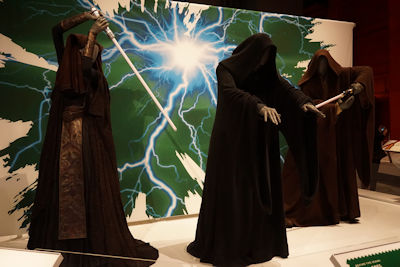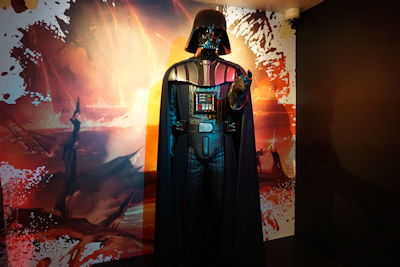
The old adage “clothes make the man” is often attributed to Mark Twain, but in reality the saying goes back over 400 years earlier to the writings of the Catholic theologian Erasmus. William Shakespeare added a similar sentiment in Hamlet with the line “The apparel oft proclaims the man,” while Homer – writing in 7 B.C. – declares of Ulysses in The Odyssey, “At first I thought his appearance was unseemly, but now he has the air of the gods who dwell in the wide heaven.”
The sentiment not only extends from Ancient Greece to Elizabethan England to even a Missourian humorist but all the way to “a long time ago in a galaxy far, far away” as well. What would the epic tale of George Lucas be, after all, without the clothes that not only make the man but the women of the Star Wars Universe? Even the designs of droids C-3PO and R2D2 – while not clothes in the traditional sense – convey their personality just as much as their actions, words and beeps.
As tribute to the clothes and attire of rebels, Jedi, princesses and queens, the Smithsonian Institute launched a travelling exhibit in 2015 entitled Star Wars and the Power of Costume. Premiering at the EMP Museum in Seattle – now known as the Museum of Pop Culture – the exhibition made its way to New York, Denver, Cincinnati, St. Petersburg and Detroit over a three year span, delighting fans with costumes from the original trilogy and prequels while offering a deeper understanding of their overall importance within the modern day myth created by George Lucas.
“For the first Star Wars film, I wanted the costumes to be simple but timeless,” Lucas explains in the 2005 book Dressing a Galaxy: The Costumes of Star Wars. “The principle characters – Luke Skywalker, Han Solo, Obi-Wan Kenobi and Princess Leia – had few costume changes, and the outfits they wore were modeled on archetypes that audiences would find understandable and familiar. Other characters – Darth Vader, C-3PO, Stormtroopers – required more complex costumes, but I still kept them to a limited palette: black, gold and white.”
The initial appearances of the characters, costumes and settings of Star Wars: A New Hope were developed by concept artist Ralph McQuarrie, and most of his designs remained more-or-less intact when costume designer John Mollo – who receive an Academy Award for his creations – transformed them from mere illustrations into the actual garbs worn by both rebel and imperialist alike.
“He didn’t want his film to look ‘spacey,’” Mollo later recalled regarding his first meeting with George Lucas. “None of the wide shoulders and flying capes of the Flash Gordon school. In fact, he said, in a memorable understatement, ‘I don’t want anyone to notice the costumes.’ He then went on to describe how he saw the two opposing factions in the film, the ‘Rebels’ and the ‘Imperialists.’ The former should be very casual and American, with a ‘Western’ look. The latter, on the other hand, very military and efficient, with a German flavor.”
George Lucas may have wanted the costumes of Luke Skywalker, Han Solo and Princess Leia – as well as Darth Vader and Stormtroopers – to be simple and low key, but that did not diminish their effectiveness or make them unmemorable. While it may indeed be their simplicity that made the characters so appealing, they were likewise far from costumes that someone wouldn’t notice and have instead become staples of cosplay at pop culture conventions around the country.
The Star Wars and the Power of Costume featured many of these designs, including the white shirt and vest of Han Solo, white turtleneck dress of Princess Leia, desert garb of the Tusken Raider sand people, and Darth Vader’s flowing black robe, helmet and breathing apparatus. Although not clothes per say, the costumes of Chewbacca, C-3PO and R2D2 were also on display – again demonstrating the effectiveness of the design ideas of George Lucas and Ralph McQuarrie.
“These costumes demonstrate the tremendous breath of the Star Wars design palette,” the Star Wars and the Power of Costume exhibit proclaimed of C-3PO and R2D2. “Yet they are just two figures in George Lucas’s fantastical galaxy – being of all shapes and sizes, representing multiple realms. C-3PO and R2D2 are among the earliest characters designed for Star Wars and decades later, their remarkable designs still have wide appeal and a strong cultural impact.”
While the original trilogy was well represented in Star Wars and the Power of Costume, an even larger selection of costumes was on display from the prequels. Multiple depictions of Padmé Amidala and her royal entourage could be seen, adding an assortment of red, yellow, orange and green to the exhibit, while the transformation of Sheev Palpatine from seemingly benevolent Senator to evil Emperor is represented by the differing colors and textures from costumes spanning the three films.
“When I began work on the prequel trilogy, I knew that a different approach was needed,” George Lucas elaborates in Dressing a Galaxy. “Instead of creating worlds worn down by the Empire, we would be visiting the Republic in its heyday, spending time in the galaxy’s lavish capital, and witnessing royalty, opulence, and advanced, albeit sometimes corrupt, civilizations. The costumes would therefore have to be much more elaborate and ornate, while still maintaining the timeless quality that is key to the Star Wars aesthetic.”
While there are many elements that make a story timeless, costumes are an often overlooked ingredient that instill a sense of character that goes beyond actions or words. Would Han Solo still be as daring, Padmé Amidala as regal, or Darth Vader as imposing if it wasn’t for the efforts of the designers that crafted their attire?
Maybe, but then again, maybe not. Thankfully the question is mute, as the power inherent within the costumes of Star Wars has become as timeless and memorable as that of the narratives themselves. Clothes may make the man, but they also make farm boys and space scoundrels, princesses and queens, rebels and imperialists, droids and Wookies, heroes and villains, and everything in between.
Anthony Letizia





